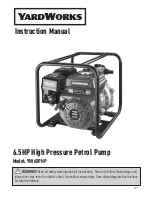
17
Figure 12: Feed trip adjustment
12.5
Gib adjustment
The table, saddle and knee are equipped with
adjustable gibs. The gibs may require adjustment if
unusual vibration is noted when locking
mechanisms are off, or if you experience unusual
vibration when spindle speed, tooth pitch or depth
of cut do not account for the vibration.
NOTE: When adjusting gibs, always start with the
knee first; adjust the saddle second, and adjust the
table last.
Figure 13: Gib locations
12.5.1
Knee gib
Loosen the two knee locking handles. The knee
gib adjustment screw (A, Figure 13) is located
under the chip wiper at rear of knee where it
contacts the column. Remove way cover and wiper
to expose gib adjustment screw. Tighten screw
until slight drag is felt when turning knee crank.
12.5.2
Saddle gib
Loosen saddle locking handle. The saddle gib
adjustment screw is on the left front of saddle (B,
Figure 13). Tighten screw until slight drag is felt
when turning cross-feed crank.
12.5.3
Table gib
Loosen table locking handles. The table gib
adjustment screw (C, Figure 13) is on the left-hand
side, beneath table. Tighten screw until slight drag
is felt when turning longitudinal table cranks.
12.6
Table lead screw backlash
adjustment
Refer to Figure 14.
The milling machine table is moved by a lead
screw and nut for each machine axis. For proper
operation, there must be clearance between lead
screw and nut, which results in backlash. A second
feed screw nut is provided to eliminate most of the
backlash. The following procedures provide
instructions for obtaining acceptable backlash.
12.6.1
Cross feed backlash adjustment
Refer to Figure 14:
1. Use cross feed crank to move table to extreme
rear of its travel (toward column).
2. Remove pleated way cover.
3. Open the two chip guards
(#48/49, sect.
15.3.1)
enough to expose cross feed
adjustment nut (the nut toward rear of feed nut
bracket is not adjustable; only front nut is
adjustable).
4. Loosen the two nut locking screws.
5. Turn nut slightly to tighten it against opposing
nut.
6. Tighten the two nut locking screws.
7. Using cross-feed crank, move table to middle
position.
8. Set up a dial indicator to check cross feed
backlash. Gently move cross feed crank back
and forth while watching dial indicator.
Backlash should be between 0.003 inch and
0.005 inch.
9. If necessary, repeat the above steps to set
backlash.
10. Install pleated way cover.
12.6.2
Longitudinal backlash adjustment
Refer to Figure 14:
1. Only one of the longitudinal lead screw nuts
can be adjusted; the other nut is fixed. The left
hand nut is typically adjustable. This can be
determined by looking at nut from underside of
table.
2. Loosen the two nut locking screws.
3. Turn the nut slightly to tighten it against the
opposing nut.
Summary of Contents for JTM-1
Page 6: ...6 5 0 JTM 1 JTM 2 installation layout Figure 1 ...
Page 21: ...21 15 1 1 Upper Head Assembly Exploded View ...
Page 24: ...24 15 2 1 Head Assembly Exploded View ...
Page 28: ...28 15 3 1 Base Assembly Exploded View ...
Page 33: ...33 16 0 Electrical Connections ...
Page 34: ...34 This page intentionally left blank ...
Page 35: ...35 This page intentionally left blank ...
Page 36: ...36 427 New Sanford Road LaVergne Tennessee 37086 Phone 800 274 6848 www jettools com ...
















































